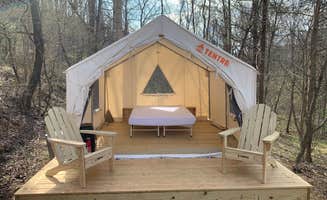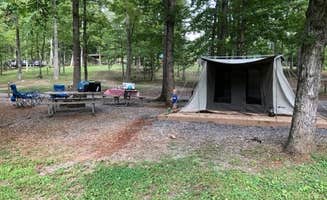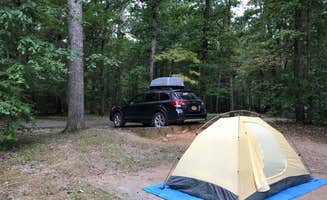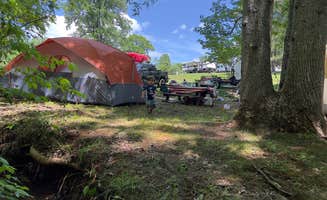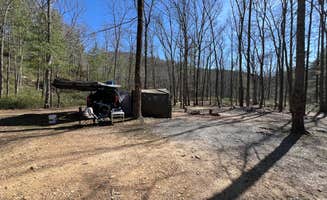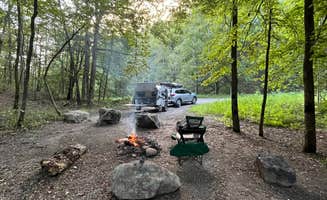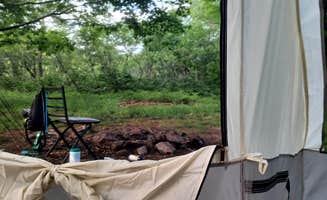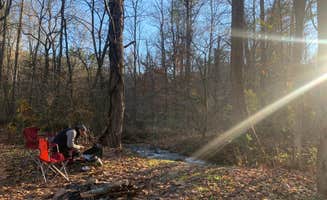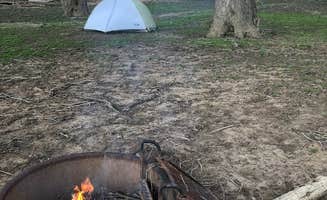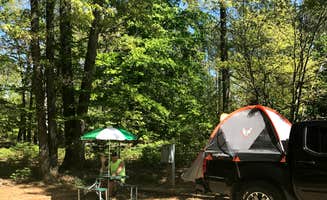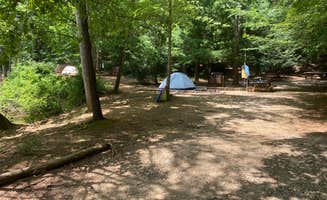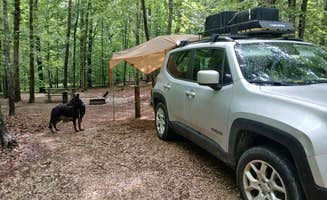Dispersed camping near Monroe, Virginia offers secluded sites in George Washington National Forest with primitive facilities and natural surroundings. Located in the Blue Ridge Mountains at elevations ranging from 700-1,200 feet, campers experience temperature swings of 15-20 degrees between day and night even in summer months. Cell service remains virtually non-existent in most wilderness areas, with signal available primarily at higher elevation overlooks.
What to do
Explore natural formations: Visit Natural Bridge State Park while staying at Natural Bridge-Lexington KOA, which serves as a convenient base camp. "Close to Natural Bridge with vineyards, restaurants and antique shops. Next door to the drive thru zoo and near Natural Bridge," notes one camper.
Fishing opportunities: Cast a line in the James River at Red Oak Campground, where "the River is absolutely clean, crystal clear water and never crowded." Multiple fishing access points make this ideal for anglers seeking solitude.
Hiking trails: Access the Appalachian Trail from free camping at Oronoco Campground. "It is very close to many hiking trails, a playground, marshland, and it is right on the James River with multiple river access points," explains one visitor. The trail connects to numerous day hikes suitable for different skill levels.
Night sky viewing: Experience exceptional stargazing at James River State Park, as "the lack of light pollution" has earned it designation as an International Dark Sky Park. Pack red-filtered flashlights to preserve night vision.
What campers like
Peaceful creek settings: At Otter Creek Campground, sites placed alongside running water create natural white noise. A camper shares, "The sites are pretty close together so there's not much privacy, but they are very well maintained. It's close to three different hikes, each a different grade."
Private forest sites: George Washington National Forest offers seclusion with "6-8 different sites, all are beautiful and most are right next to the creek. There was a fire ring and man made stone oven at the site we chose." Sites are first-come, first-served with no reservations accepted.
River access: Canoe Landing Group Campsite features riverside camping where "you can fish right off the bank less than 50 yards from your tent." The proximity to water creates opportunities for swimming and wading during warm months.
Clean facilities: Campers consistently note the quality of bathhouses at Devils Backbone Camp, describing them as "top notch! Squeaky clean with lots of space." The campground's unique brewery connection adds appeal for adult campers.
What you should know
Seasonal operation: Most campgrounds close from late fall through early spring. "Otter Creek Campground typically operates from May 6 to October 29," while Cave Mountain Lake Family Camp runs "April 1 to October 31."
Limited services: Many forest service sites lack amenities. At George Washington National Forest dispersed sites, there's "no running water" and campers must "pack all trash out." Bring all supplies, including drinking water and toilet paper.
Reservation requirements: Popular campgrounds fill quickly, especially on weekends. At Devils Backbone Camp, be aware of their "2-night minimum to tent camp" policy, which applies even on weekdays during peak season.
Terrain considerations: Sites vary significantly in terrain. One camper at Lynchburg KOA noted, "My water pressure was good but talking to other campers, the farther away you get from the front of the park the worse the water pressure gets."
Tips for camping with families
Kid-friendly amenities: Yogi Bear's Jellystone Park offers extensive recreation options as "there was a carnival for the kids, trick-or-treating, hiking, tons of bike riding, campfire watching, hammock swinging." The campground includes "playgrounds, mini golf, a game room, air pillow, a pool with a kids area and water slides."
Stream exploration: Cave Mountain Lake Family Camp provides natural play areas where "our boys loved playing in the stream and climbing the hill to get to our hammock on the site too." Children can search for wildlife in shallow water areas.
Protected swimming: Several campgrounds offer designated swimming areas. At James River State Park, "the lake is very cold but fun" and children enjoy "catching salamanders and tadpoles while some of us fished."
Educational opportunities: Natural Bridge State Park offers ranger-led programs. "We enjoyed a fire making class followed by s'mores on Friday night and then an owl searching hike on Saturday night," making camping both fun and educational.
Tips from RVers
Site selection: At Natural Bridge-Lexington KOA, request specific site types based on your needs. "If you were on an odd number site, you either had to hope you had the length on your water and power lines to run to the opposite side of your rig or you had to pull into the site the opposite way."
Limited big rig access: Many forest service campgrounds cannot accommodate larger RVs. At Oronoco Campground, the "road is a little bumpy in places" requiring careful navigation for longer vehicles.
Power considerations: Electricity availability varies widely. At Lynchburg KOA, one camper in site B31 reported "water pressure was good" while those farther from the entrance experienced issues, suggesting locations closer to main facilities provide more consistent utilities.
Dump station access: Even when full hookups aren't available, some campgrounds provide dump stations. One RVer noted at Devils Backbone Camp that "if your sewer hose does not fit, they do have a dump station on site" as a backup option.


